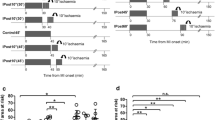Abstract
Background: A reduction in coronary flow leads to a parallel decrease in contractile function. Thus, a flow/function balance is established in the myocardium under certain circumstances avoiding the development of a necrosis (referred to as “hibernating” myocardium). The impact of a preconditioning period on this critical balance was examined.
Methods: In 116 isovolumetrically beating rat hearts, 3 h of hypoperfusion with 15% of control coronary flow were performed followed by 1 h reperfusion; 40 hearts served as controls. As a preconditioning period, in half of the rat hearts a 5 min no-flow ischemia followed by 10 min reperfusion was performed, preceding the prolonged hypoperfusion.
Results: Systolic function was identically reduced in both groups after 3 h hypoperfusion (LVP: 39±2 mmHg, 40±2 mmHg vs. controls 90±3 mmHg; p<0.01). Without preconditioning hypoperfusion resulted in a marked initial decrease in function. This period was followed by an adaptation to a higher steady state level of function compared with non-preconditioned hyperperfused hearts (p<0.05). After preconditioning hypoperfusion directly resulted in this level of contraction. Contractile reserve was reduced (p<0.01) identically in both hypoperfusion groups. Adenine nucleotides were decreased (p<0.01) after 3 h hypoperfusion to 2.1±0.2 μmol/gww vs. controls (4.7±0.2 μmol/gww). After initial preconditioning adenine nucleotides were better preserved (3.2±0.2 μmol/gww) going ahead with a creatine phosphate overshoot of 126% (p<0.01). After reperfusion, systolic function and contractile reserve were identical in both groups.
Conclusion: A period of preceding no-flow ischemia followed by reperfusion modifies functional adaptation to hypoperfusion and preserves high energy phosphates. Therefore, the metabolic balance during hypoperfusion is improved by preconditioning, although no impact on contractile reserve or the functional status of reperfused myocardium after low-flow ischemia can be seen.
Similar content being viewed by others
Author information
Authors and Affiliations
Additional information
Received: 12 March 1998, Returned for 1. revision: 25 March 1998, 1. Revision received: 12 May 1998, Returned for 2. revision: 2 June 1998, 2. Revision received: 13 July 1998, Accepted: 21 July 1998
Rights and permissions
About this article
Cite this article
Hoffmeister, H., Ströbele, M., Bäßler, A. et al. Preconditioning preserves energy metabolism in prolonged low-flow ischemia. Basic Res Cardiol 93, 487–496 (1998). https://doi.org/10.1007/s003950050119
Issue Date:
DOI: https://doi.org/10.1007/s003950050119




